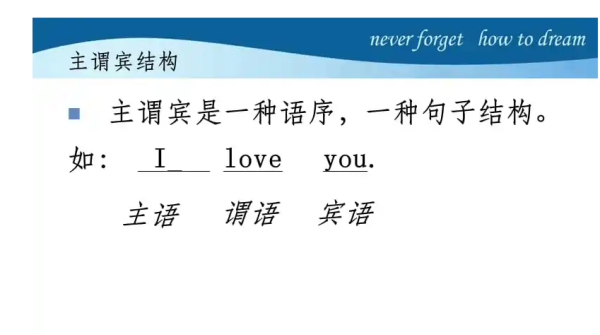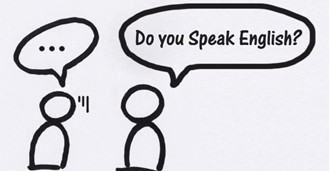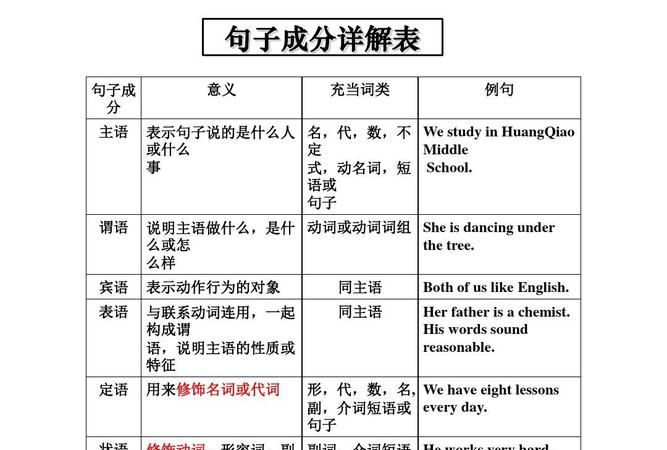本文目录
英语句子成分的详细解释 主语谓语表语宾语宾语补足语定语状语等的详细用法和解释
主语:句子陈述的对象,说明是谁或什么,或执行句子的行为或动作的主体。
①【My school】 is not far from my house.
②【To do such a job 】needs more knowledge.
谓语:对主语动作或状态的陈述或说明,指出“做什么”、“是什么”或“怎么样”。
①It【 is used by】 travelers and business people all over the world.
②I【 made】 your birthday cake last night
宾语:一个动作(动词)的接受者。
①He didn't say 【anything. 】
②They sent 【the injured to hospital.】
表语:用来说明主语的身份、性质、品性、特征和状态的成分。
①That remains 【a puzzle】 to me.
②The sun is 【up.】
定语:用来修饰、限定、说明名词或代词的品质与特征的成分。
①In science, a theory is a reasonable explanation【 of observed events】.
②Possible solutions 【to the problem】 are formulated.
状语:谓语里的另一个附加成分,从情况,时间,处所,方式,条件,对象,肯定,否定,范围和程度等方面对谓语中心进行修饰或限制。
①【In a way,】any hypothesis is a leap into the unknown.
②It extends the scientist's thinking 【beyond the known facts】.
主语补足语:被动语态中的宾语补足语。
①The dog is called 【Karl】.
②The door was painted 【white】.
宾语补足语:某些及物动词的宾语后面还需要有一个补足语,意思才完整,宾语和它的补足语构成复合宾语。
①He proved that theory【 very important】.
②I'd prefer you【 to leave him alone】.
插入语:在一个句子中间插入的一个成分,不作句子的何种成分,也不和句子的何种成分发生结构关系,同时既不起连接作用,也不表示语气。
①One advantage of his icebox,【 Moore explained】, was something.
②The success of the Colorado beetle in infesting potatoes, 【for example】, seems to be correlated with its high tolerance to alkaloids.
连接词:连接短语或子句的句子成分。
①That is, they become diseased 【and 】die.
②The baby boomers began streaming into the first grade by the mid-1940's 【and】 became a flood by 1950.
同位语:对另一个名词或代词进行修饰,限定或说明的名词或其它形式。
①A new household convenience, the icebox, 【a precursor of the modern refrigerator】, had been invented.
②Most of them range in size from $5,000 to $12,500, 【a welcome sum to many young practitioners.】
系动词:本身有词义,但不能单独用作谓语,后边必须跟表语,构成系表结构说明主语的状况、性质、特征等情况。
①That【is】 air wrung dry of moisture.
②There【 seem to have been 】several periods within the last tens of thousands of years.
形式主语:形式主语是动词不定式的一种,它也是逻辑主语, 可以把它归类到逻辑主语的第一种(不定式的逻辑主语) 用作宾语的不定式,用作目的状语,用作结果状语的不定式都是属于不定式的大概念里面的。
①It is no use 【reasoning with him】.
② It was pretty hard for him 【to bring up the child on his own.】
形式宾语:形式宾语是动词不定式的一种,它也是逻辑宾语, 可以把它归类到逻辑宾语的第一种(不定式的逻辑宾语) 用作主语的不定式,用作目的状语,用作结果状语的不定式都是属于不定式的大概念里面的。
①I find 【it 】difficult 【to talk to you.】
②I think 【it】 intresesting 【to dance.】
间接宾语:当看到句子中有两个宾语时,其中指物或指事的就是直接宾语,指人(或动物)的就是间接宾语。(不能按宾语离动词的远近来判别)
①I teach【 him】 English.
②I wrote【 my father】 a letter yesterday.
连接词/标志词:连接词是连接单词、短语或子句的词语, 不能独立充当句子成分。
①Air 【and 】water are indispensable to me.
②You may come【 if 】you want to.

英语句子成分详解及例句
英语句子主要由主语、谓语、宾语三个成分构成。

1、主语:主语表示句子主要说明的人或者事物。能够做主语的形式通常有:名词(n),代词(pron),数词(num),不定式(to do),动词-ing形式,和主语从句等。
2、谓语:谓语在句子中说明主语的动作,特征,行为或状态。通常由动词或动词短语作谓语。
3、宾语:宾语是指一个动作的接受者。一般位于及物动词和介词之后,可以做宾语的形式有:名词(n),代词(pron),数词(num),不定式(to do),动词-ing形式,和宾语从句等。

例句:I'm interested in writing.我对写作很感兴趣。(主语是I我,谓语是am interested in感兴趣,宾语是writing写作)
英语中的句子成分详解
英语的句子成分主要有七类。分别是主语、谓语、表语、宾语、同位语、定语、状语。
1、主语:主语说明谓语所表示的动作或状态的执行者。名词(短语)、代词、数词、不定时(短语)、动名词(短语)和从句均可充当主语。
例句:A light wind disturbed the surface of the water.微风使水面泛起涟漪。(名词短语作主语)
2、谓语:谓语用来描述主语的行为动作或所处的状态。谓语的中心词是限定动词,有人称、数和时态的变化。
例句:I have tried this way three times.我用这种方法试了三次。
3、表语:表语与前面的系动词一起构成复合谓语,用来说明主语的特征、类属、状态、身份等。
例句:Anita is a Canadian.安妮塔是加拿大人。(名词作表语)
4、宾语:宾语有单宾语、双宾语、复合宾语等,双宾语又分为直接宾语和间接宾语。
例句:We love pace.我们热爱和平。(直接宾语)
5、同位语:对句子中某一成分作进一步解释说明。
例句:They each can get a chance to travel by air.(代词作同位语)
6、定语:定语是用来描述名词或代词的修饰语。
例句:It is a difficult problem.这是一个棘手的问题。(形容词作前置定语)
7、状语:状语是用来修饰动词、形容词、副词和句子的一种成分。
例句:Arriving there,call me up.到了之后,给我来个电话。(现在分词作状语)

扩展资料:
组成句子的各个部分叫做句子成分。主语和谓语是句子的主体部分,其他处于次要部分。英语中的基本句型为主语+谓语;主语+谓语+宾语;主语+连系动词+表语;主语+谓语+间接宾语+直接宾语;主语+谓语+宾语+宾语补足语。
参考资料:百度百科——句子成分
常见的句子成分有哪些在英语中有什么作用
英语句子成分:
主要成分:主语、谓语、宾语、【表语 汉语中没有此成分】
次要成分:定语、状语、宾补/主补、同位语.
插入语,属于修辞类的功能形式,一般都不作为句子成分看待.
例如:
【To see 主语】【is谓语】【 to believe.表语】
【He 主语】【came to 谓语】【school 宾语】【late again.状语】
【We主语】【 Chinese同位语】【 should try harder谓语】 【to make our country stronger and more powerful 宾语】
to make【 our country 宾语】【stronger and more powerful 宾补】
Jack is a 【wise定语】 man

以上就是关于英语句子成分的作用和用法,英语句子成分的详细解释 主语谓语表语宾语宾语补足语定语状语等的详细...的全部内容,以及英语句子成分的作用和用法 的相关内容,希望能够帮到您。

